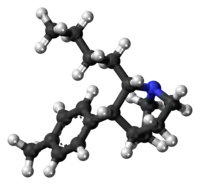 | |
 | |
| Clinical data | |
|---|---|
| ATC code |
|
| Legal status | |
| Legal status |
|
| Identifiers | |
| |
| CAS Number | |
| PubChem CID | |
| ChemSpider | |
| UNII | |
| Chemical and physical data | |
| Formula | C18H27N |
| Molar mass | 257.421 g·mol−1 |
| 3D model (JSmol) | |
| |
| |
| (verify) | |
2-Butyl-3-(p-tolyl)quinuclidine (BTQ) is a stimulant DRI.[1] It is one of a number of substituted quinuclidine derivatives developed as potential medications for the treatment of cocaine abuse,[2] and produces similar effects to cocaine in animal studies, although milder and longer-lasting.
See also
References
- ↑ Sakamuri S, Enyedy IJ, Zaman WA, Tella SR, Kozikowski AP, Flippen-Anderson JL, et al. (March 2003). "2,3-Disubstituted quinuclidines as a novel class of dopamine transporter inhibitors". Bioorganic & Medicinal Chemistry. 11 (6): 1123–36. doi:10.1016/S0968-0896(02)00450-9. PMID 12614900.
- ↑ Enyedy IJ, Sakamuri S, Zaman WA, Johnson KM, Wang S (February 2003). "Pharmacophore-based discovery of substituted pyridines as novel dopamine transporter inhibitors". Bioorganic & Medicinal Chemistry Letters. 13 (3): 513–7. doi:10.1016/S0960-894X(02)00943-5. PMID 12565962.
This article is issued from Wikipedia. The text is licensed under Creative Commons - Attribution - Sharealike. Additional terms may apply for the media files.